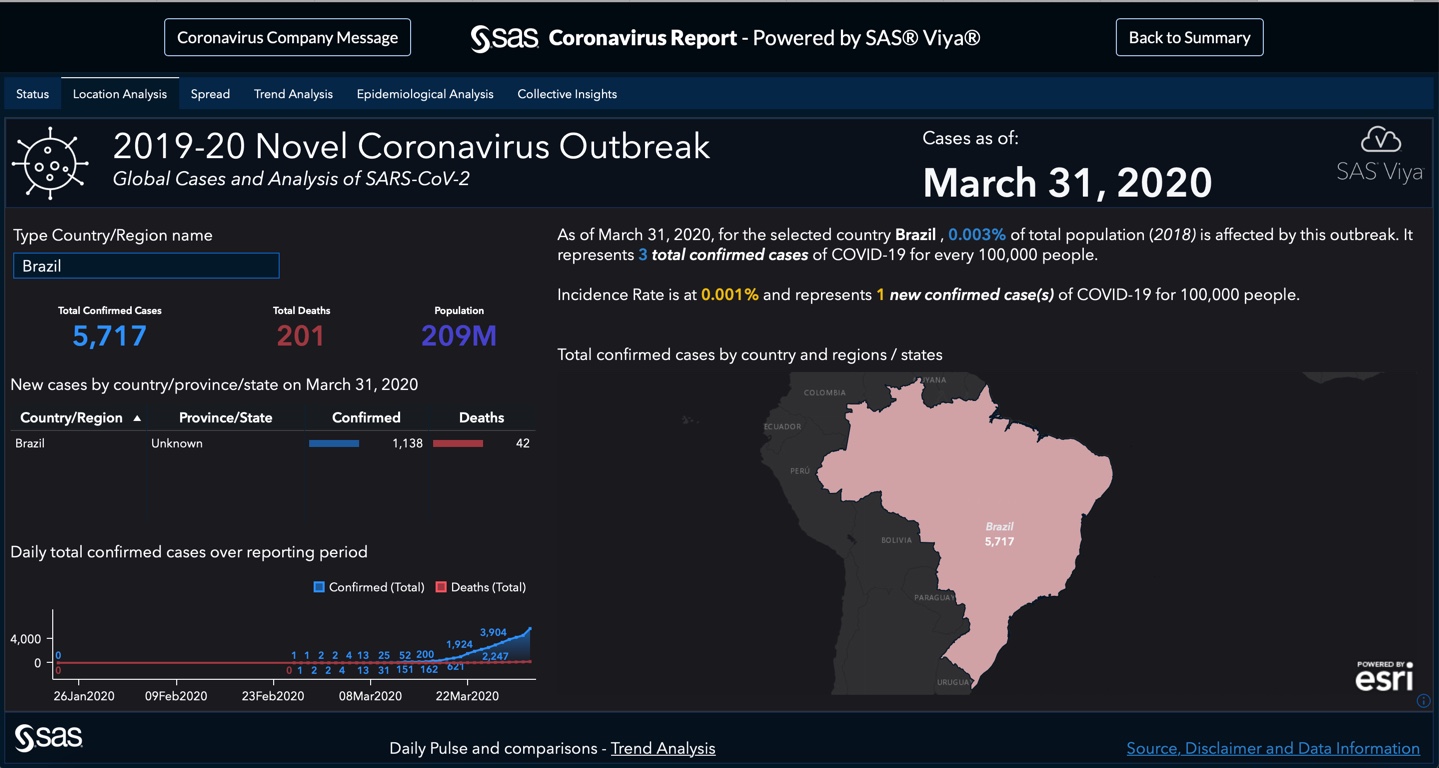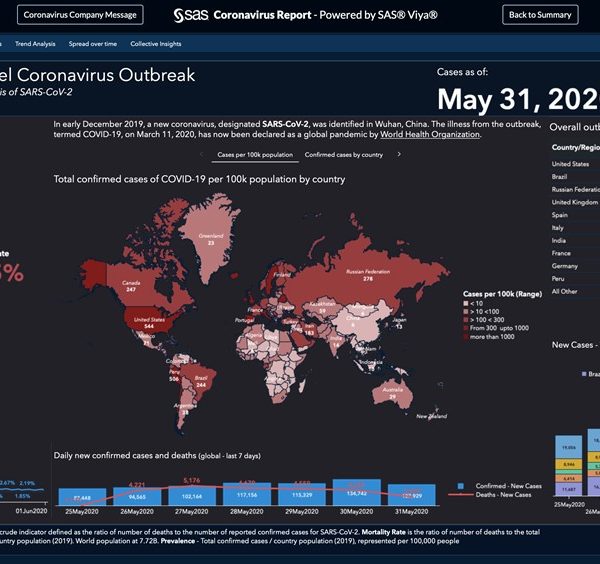
공공 고객 세미나 통해 공중보건과 공공사회서비스 개선을 위한 해법 제시 SAS코리아는 지난 5월 23일과 24일 양일간 공공 부문 고객들을 대상으로 ‘공중보건 전문가를 위한 SAS Public Health 세미나’와 ‘공공사회서비스 전문가를 위한 SAS Social Services 세미나’를 JW메리어트 호텔에서 개최했습니다. [사진1] 공중보건 전문가를 위한 SAS Public Health 세미나 장면 소외 계층 없이 전

공공 고객 세미나 통해 공중보건과 공공사회서비스 개선을 위한 해법 제시 SAS코리아는 지난 5월 23일과 24일 양일간 공공 부문 고객들을 대상으로 ‘공중보건 전문가를 위한 SAS Public Health 세미나’와 ‘공공사회서비스 전문가를 위한 SAS Social Services 세미나’를 JW메리어트 호텔에서 개최했습니다. [사진1] 공중보건 전문가를 위한 SAS Public Health 세미나 장면 소외 계층 없이 전

The cold of winter and holiday gatherings push people indoors, causing a surge in influenza hospitalizations. Years of above-normal temperatures in southern states bring a species of mosquito that carries malaria to the US. Declining childhood immunization rates threaten to allow previously eradicated diseases like measles to become endemic again.

Did you know that approximately one in 28 children grows up with a parent behind bars? That’s not just a number – it’s a glimpse into the lives of young people who face this challenge and need support to break the cycle. According to the US Department of Health and

Data has emerged as a crucial weapon in the battle against the overdose epidemic in the United States. Government agencies nationwide are grappling with social issues such as gun violence, gang activity, burglaries and homelessness to go along with the enduring overdose crisis. Addressing these issues requires using data to

Crises like the COVID-19 pandemic have increased the demand for public health experts who possess advanced analytics skills. After all, data – when properly collected, analyzed and understood – has immense power to inform decision-making. And in areas like public health, informed decision making can save lives. Azhar Nizam has

Dedicated people, funding and data analytics can join forces to battle the opioid epidemic.

この記事はSAS Institute Japanが翻訳および編集したもので、もともとはMark Lambrechtによって執筆されました。元記事はこちらです(英語)。 世界的な公衆衛生問題が拡散する際、初期段階では多くの不明事項が存在するものですが、新型コロナウイルスのように急速な感染拡大の場合は特にその度合が高まります。データ・ビジュアライゼーションは、傾向を理解したり、複数のデータポイントから意味のあるストーリーを組み立てたりするための優れたスタート地点となりえます。ウイルスの拡散状況を視覚化できる機能は、問題意識の喚起、そのインパクトの理解、そして究極的には予防努力の支援に役立つ可能性があります。 2019年12月31日、世界保健機関(WHO)の中国オフィスは、中国湖北省の武漢市で検知された原因不明の肺炎の感染ケースについて報告を受けました。最初の報告以降、この新型コロナウイルス(SARS-CoV-2)は世界的な感染拡大を見せており、感染者は30ヶ国以上の数万人に及び、「新型コロナウイルス感染症(COVID-19)」と呼ばれる急性呼吸器疾病を引き起こしています。 この状況を受け、SASは新型コロナウイルスの現況、場所、拡散状況、トレンド分析を描き出すインタラクティブなレポートを作成しました。 元になるデータは日次で更新されており、感染拡大の進行状況を定期的にチェックすることや、世界的な拡散状況を時間軸に沿ったアニメーションで確認することができます。この対話操作型レポートでは以下のことが行えます。 過去10日以内に新たに確認された感染者の数を調べ、このウイルスの感染率、回復率、死亡率がどのように推移しているかを確認する。 このウイルスがどの地域に侵入したかを調べ、発生地の中国と世界の残りの地域とで状況を比較する。 感染確認済みのケースを分析することで、回復率が時の経過に沿ってどのように変化しているかを理解する。 このレポートはSAS Visual Analyticsと、WHO、CDC、ECDC、NHC、およびDXYからのデータ(JHU CSSEによってコンパイルされたもの)を用いて作成されています[訳注:JHU CSSE=米国ジョンズ・ホプキンズ大学システム科学工学センター]。 SAS Visual Analyticsで作成した新型コロナウイルス・レポートの概要 「新型コロナウイルス感染症(以下、COVID-19)」の感染拡大に関するサマリー情報を手早く確認したい場合は、こちらをご覧ください。 このサマリー情報は、世界各地の統計情報を用いて日次で更新されています。このWebページのこれ以降では、各種レポートからの重要な洞察をスクリーンショットでご紹介します。実際のレポートでは、最新のデータに基づき、ご自身で対話操作しながら統計情報や分析結果を閲覧することができます。 地域別の詳細情報を確認したい場合や、対話操作型レポート全体を探索したい場合は、サマリー情報ページの右上隅にある「Full Report」ボタンをクリックすると、完全なダッシュボードを起動できます。 最初に表示されるダッシュボード・ビュー([Status]タブ)では、日次で更新されるデータに基づき、COVID-19の感染拡大の概況を簡単に確認できます。具体的には、新たに確認された感染者数、回復者数、死亡者数などを地域別にフィルタリングして閲覧することができます。 図1: COVID-19の感染拡大の概況。新たに確認された感染者数、回復者数、死亡者数などを地域別にフィルタリングして閲覧することができます。 レポートの[Locations]タブ(下の図2)では、 全世界および特定国の新型コロナウイルス関連データを確認できます。 図2:[Locations]タブでは、全世界および特定国の新型コロナウイルス関連データを確認できます。 特定国のデータを見るには、左上のフィールドに国名を入力します(下の図3)。 図3: 国名を入力すると、その国の詳細情報だけに集中することができます。 新型コロナウイルスの最初の感染者が中国で報告されてから既に何週間も経過しており、感染拡大は世界各地へと広がっています。私たちは、Esri社のGISマッピング・ソフトウェアから取得した地理空間データのレイヤーを追加することで、対話操作型の画面を用いて、中国とその他の国々にまたがる形で新型コロナウイルスの拡散状況を探索できるようにしました。 [Spread]タブでは、SAS Visual Analyticsの時系列アニメーション機能(下の図4)を用いて、ウイルスが世界全体に拡散していく様子を見ることができます。アニメーションを再生すると、中国国内での拡散状況や、世界全体の拡散状況および深刻度を確認できます。 図4: 時系列アニメーションで、ウイルスが世界全体に拡散していく様子を見ることができます。 [Trend Analysis]タブでは、様々なビジュアライゼーションを切り替えながら、COVID-19の感染拡大に関連したその他のデータの傾向を見ることができます(下の図5)。 図5: 日次の感染者数/死亡者数のトレンド分析 [Epidemiological Analysis]タブでは、罹患率および有病率を見ることができます。 図6: 10万人あたりのCOVID-19感染者数を国ごとに見る 図7: 期間有病率を国または地域ごとに見る [Collective Insights]タブは、全世界のまたは国ごとの感染拡大状況を1つの表にまとめています(下の図8)。

In the early days and weeks of any widespread global health concern, particularly in a fast-moving outbreak like the coronavirus, there are many unknowns. Data visualization can be a good starting point to understand trends and piece data points together into a meaningful story. The ability to visualize the spread

As we honor Mental Health Month, there are many calls to reduce suffering. Seems reasonable, right? It’s even in California’s Mental Health Services Act (MHSA), where public systems are called to “reduce subjective suffering.” And as we broadly focus more on outcomes in health, measuring suffering (and hopefully its reduction)

Many of the buzzy applications of AI in healthcare we hear about involve medical IoT, computer vision for radiology or disease prediction. But the fact is, many health institutions that just aren’t there yet with adoption. With limited budgets and dated systems, can public health agencies tap into the power

People across the country (and world) are not getting the care they need. There are many data efforts to address that, but I personally believe traditional analytics are short-sighted, too illness-focused, and remarkably negative. We need to take a more holistic approach to data, policy, and health care, including traditional

What message do former Google CEO Eric Schmidt, CMS Administrator Seema Verma, and White House Senior Advisor Jared Kushner have in common? They all asserted the importance of person-centered care in their respective remarks at HIMSS two weeks ago in Las Vegas. Person-centered care treats the patient/healthcare consumer as an

Native American health continues to lag behind other populations in the US. In fact, the American Indians and Alaskan Natives (AI/AN) population lives, on average, 4.4 fewer years than the rest of the US population, and is experiencing significant disparities in a variety of health indicators. The numbers reveal this stark

A new book from SAS guides public sector leaders in the use of data to address a wide range of state and local government challenges. Each chapter deals with critical issues facing our country, including the opioid epidemic, child abuse, spiraling health care costs, prison overcrowding, education reform, rampant fraud and the

I recently attended the Medicaid Management Information System (MMIS) Conference in Austin, Texas. The MMIS conference is an annual event for federal and state HHS agencies to share programmatic and technology initiatives in Medicaid and Children’s Health Insurance Programs (CHIP). While I have attended numerous MMIS conferences in the past, I